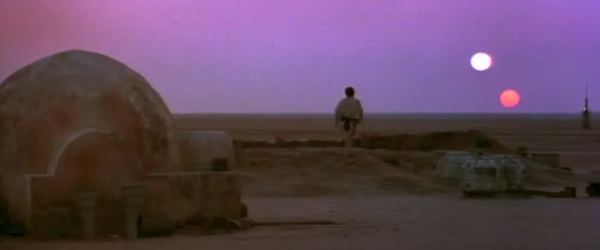Alien Earths Could Have 2 Suns Like 'Star Wars'' Tatooine

This story was updated at 11:55 a.m. ET.
AUSTIN, Texas — Astronomers should hunt for worlds like the fictional Tatooine in "Star Wars," say researchers calculating whether Earth-like planets can exist around paired stars.
In the "Star Wars" universe, Tatooine was a circumbinary planet, meaning it was a world that had two suns. NASA's Kepler space telescope helped discover the first real-life circumbinary planet, Kepler-16b, in September. However, the world in question was a gas giant like Jupiter, not a terrestrial world like Earth.
Now astrophysicists from the University of Texas at Arlington suggest Earth-like worlds could exist in the habitable zones around binary systems. These regions are neither too hot nor too cold to support liquid water on its surface, and thus life as we know it.
"This is an assessment of the possibilities," said study co-author Zdzislaw Musielak, of the University of Texas at Arlington, in a statement. "We're telling them where a planet has to be in the system to be habitable. We're hoping they will look there." [Real-Life Planets That Could Be in "Star Wars"]
The researchers used the Kepler-16 twin sun system as a starting point. The habitable zone of this system is centered mostly on the system's primary star and extends in a region around it equal to 0.36 to 0.71 the distance of the Earth to the sun. This corresponds in our system to a distance from between Earth and Venus to about Mars.
"This work is informed by observations and it has the potential to trigger more observations," said study co-author Manfred Cuntz at the University of Texas at Arlington.
Get the Space.com Newsletter
Breaking space news, the latest updates on rocket launches, skywatching events and more!
One possibility the researchers explored involved an Earth-sized planet that directly orbits the binary system at distances outside its conventional habitable zone. This corresponds to a distance from the system's primary star equal to twice the distance from Earth to the sun.
To host life in this extended region, such a planet would need high levels of greenhouse gases such as carbon monoxide or methane in its atmosphere to trap warmth.
"We determined that a habitable Earth-like exoplanet is possible in the extended habitable zone," study lead author Billy Quarles at the University of Texas at Arlington told SPACE.com. "There is less light from the star, so the planet itself has to maintain more heat."
Another possibility involved an Earth-sized moon of a gas giant in the habitable zones of Kepler-16.
"We determined that a habitable exomoon is possible in orbit around Kepler-16b," Quarles said.
Other more exotic possibilities the researchers are considering include an Earth-sized planet around the twin stars that gets captured by a gas giant in the system to become a moon, as well as an Earth-sized world in a so-called Trojan orbit equidistant from the gas giant Kepler-16b and the binary system's primary star. Calculations regarding these possibilities are ongoing, Quarles said.
The scientists detailed their findings Jan. 9 here at the annual meeting of the American Astronomical Society. They have also submitted their findings to the Astrophysical Journal Letters.
Follow SPACE.com for the latest in space science and exploration news on Twitter @Spacedotcom and on Facebook.
Join our Space Forums to keep talking space on the latest missions, night sky and more! And if you have a news tip, correction or comment, let us know at: community@space.com.

Charles Q. Choi is a contributing writer for Space.com and Live Science. He covers all things human origins and astronomy as well as physics, animals and general science topics. Charles has a Master of Arts degree from the University of Missouri-Columbia, School of Journalism and a Bachelor of Arts degree from the University of South Florida. Charles has visited every continent on Earth, drinking rancid yak butter tea in Lhasa, snorkeling with sea lions in the Galapagos and even climbing an iceberg in Antarctica. Visit him at http://www.sciwriter.us